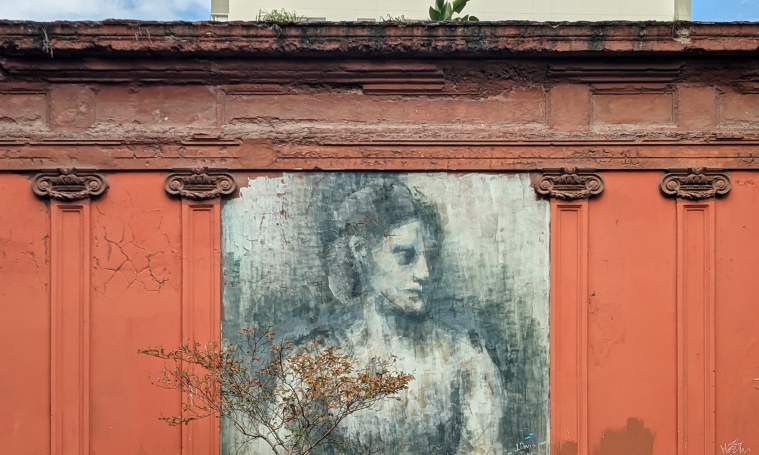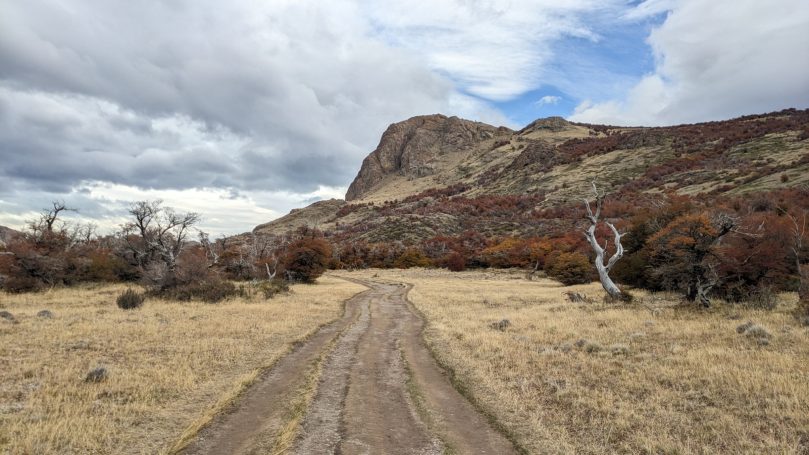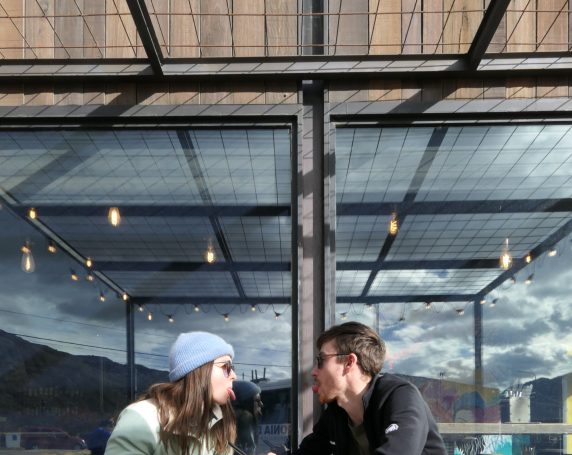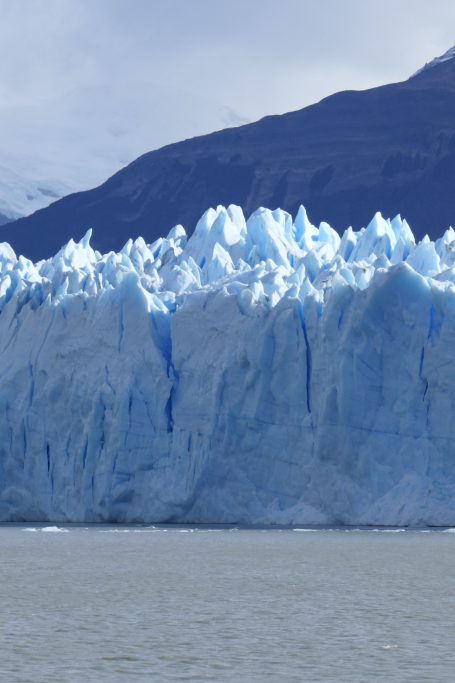Hasta pronto Argentina
***Deutsche Version***
On 10 April, we finally set off! After what felt like an eternity of preparation, it was suddenly over too fast, and we were on the plane to Buenos Aires.
Our first encounter in Buenos Aires, a city of 13 million people, was with a Swiss couple in a randomly chosen café in the San Telmo district. He, aged 84, and she, 80, have been coming to South America on and off for years. After eating in their favourite café (which also became our favourite café), they set off to dance tango in the beautiful weather. This fantastic encounter at the start of our trip was so inspiring.
Buenos Aires reminded us strongly of a mixture between New York and Volos. Volos because of the pavements with the many trees and the changing paving slabs. The many wonderfully furnished cafés and bars also evoked the small Greek town. Furthermore, there are many unfinished buildings, partly because the money ran out, and beautiful flats with staircases still under construction because no one wanted to pay for common areas.
The similarity to New York, apart from the size of the city, relates to the diversity and tolerance of the people. It was not uncommon to see locals slipping beggars some change. Something you rarely see with us. Moreover, the people in Buenos Aires love their dogs at least as much as the New Yorkers. Whether old or young, the four-legged friends were their faithful companions. The wiggly sausage dog seems to be the most popular.

As in any big city, there are also some downsides. The crime rate seems to be relatively high. You shouldn't be in specific neighbourhoods in the evening, and you could observe how people in the metro always carried their backpacks towards the front. An indication that pickpocketing is common.
We only saw a fraction of this enormous city in the five days. Nevertheless, we got a small glimps into the life of Argentines in Buenos Aires in the neighbourhoods of San Telmo, Barracas, La Boca and Palermo—all very different areas. What they all have in common, however, are the many parks and the countless ancient trees. You can also buy any houseplant in any shop, no matter how small. The numerous ice cream parlours (“heladerías”) also seem to be very popular. As we learned from our guide in Barracas, Argentines love “helados”, regardless of the weather or time of day. Buenos Aires was also adorned with countless street paintings. Again and again, we discovered smaller and larger works of art, funny and critical but also historical ones.
To close up our experiences in Buenos Aires, a short story about our washing machine debacle. The washing slot was perfectly planned into our daily programme. However, when we came back to wash the next load, the washing machine door just wouldn't open. For about 20 minutes, we tried everything. We started the drying programme by mistake, which could not be stopped even by unplugging the machine. We let it happen and went on exploring. When we returned a few hours later, the machine still wouldn't open. We searched every YouTube video and every blog for tips—no chance. As we didn't have any luck the following day either, we wrote to our host, as we didn't want to leave some of our clothes behind at our first destination. At first, she probably must have thought that we were a little nuts. But luckily, she sent for a handyman on Saturday anyway. To our relief, it took him 30 minutes to open the machine, and he had to unscrew everything. Our laundry finally made it out again after almost 24 hours.

From the big city, we went on to the rugged south. More precisely, to the small village of El Chalten in the heart of Patagonia, the hiking mecca of Argentina.
We don't know how many have done a 33 km hike after a week in the city—we did. We set off early in the morning. Despite low temperatures and steady wind, we quickly warmed up. As soon as the sun appeared over the mountains, we could marvel at the beautiful landscape in its autumn colours.
After a leisurely first section, it became really strenuous. The steep and exposed final slope to the Laguna de los tres was a real challenge. In addition to the partly icy surfaces, we were repeatedly surprised by insidious gusts of wind (Jana's cap was saved at the last second). But the climb was definitely worth it. There was a unique panorama with striking mountain peaks, an impressive glacier and a turquoise mountain lake. After marvelling at the remarkable scenery, we started our way back. Staying up there for too long in the nasty conditions was impossible. We decided to take a longer route back along two mountain lakes. Virtually all by ourselves, we could once again marvel at the Patagonian autumn in all its splendour. However, this luxury was not in vain. The last few kilometres were a real challenge.
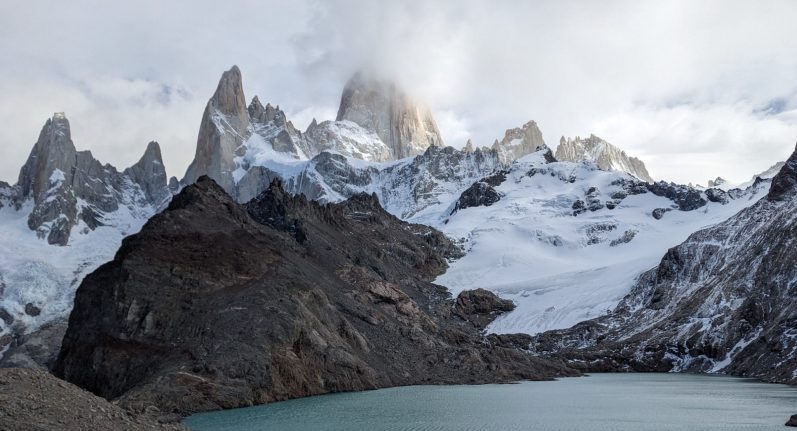

We were proven wrong whenever we thought we would see the finish line behind the next hill. Driven by the happy hour until 19:00 (it turned out that the happy hour would have gone until 20:00), we made it back before that time with our last ounce of strength. One dinner and two glasses of red wine (aka four Swiss glasses) later, we went to bed, accompanied by countless bursts of laughter and completely overtired. The next day we took it easy. After a walk to a small waterfall, we started our bus journey to El Calafate in the evening.
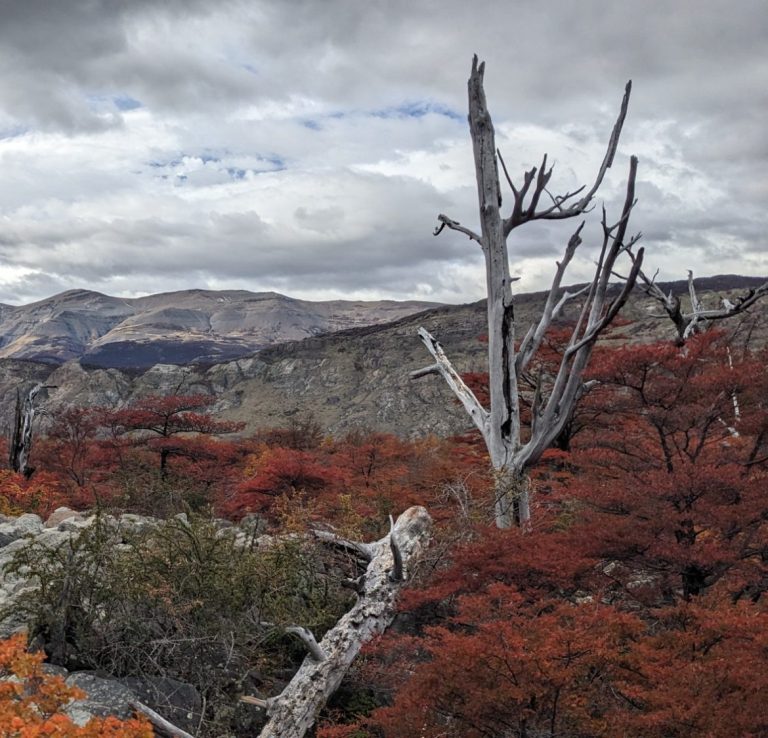

El Calafate is the starting point to the notorious Perito Moreno Glacier. The glacier originates from the southern Patagonian ice field, the third-largest ice field in the world. We admired the impressive landscape with the unimaginably vast and enormous ice masses. Particularly spectacular were the break-offs of larger chunks of ice from the melting ice tongue. A thunderous and deep sound marked the break-off, and sloshing water masses accompanied the several tons of ice mass for minutes. We enjoyed the subsequent boat trip, bringing us closer to the glacier. With crampons, we were even allowed to do a short circular walk on the approximately 400-year-old ice.
On our last evening, we also wanted to try the speciality of Asado. The meat is roasted over hot coals for several hours, served with a chimichurri marinade, and usually potatoes with vegetables. We already knew before our trip that Argentines love meat above all else. But we also noticed on the first day in Buenos Aires that everyone always carries their mate cup and a thermos flask everywhere. Some even have a unique bag, so they always have everything ready to hand and can pour a new mate cup even when waiting for the metro. Hot water for the thermos can be refilled at any takeaway stall or restaurant. There are even water vending machines in some places, and all kettles have a particular mate stage. In the supermarket, you can buy a hundred different mate leaves.

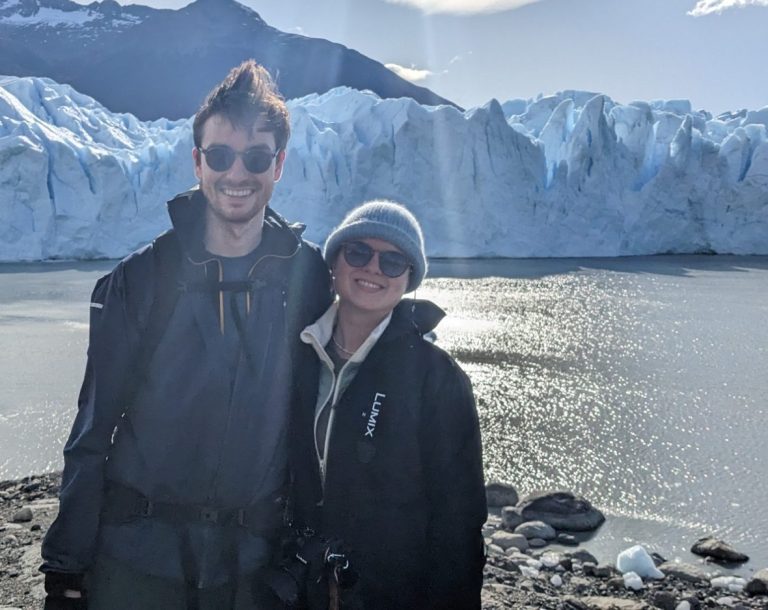
Fortunately, we had to deal with the financial aspects in Argentina less intensively than many before us. On 4 November 2022, the Argentine Central Bank introduced a preferential exchange rate for foreign tourists. This means that payments made in Argentina with foreign credit cards will now be processed at this rate. We tested this and paid with our Mastercard. We were automatically refunded the difference to the official US dollar rate a few days later. This was a great relief for us. The exchange rate was still a little worse than the “Dollar Blue” rate, but we didn't have to search for WU locations all the time and queue up only to not get any in return. You can find more detailed information below if you want to know more about Argentina's financial situation.

After intense 1.5 weeks, our time in Argentina was already over. A little wistfully, we drove through the endless steppe landscape and said goodbye to this great country. Of course, the two bus drivers shared a mate again, the cup, this time a cow's foot (very hard to get used to ;)). We were able to experience a lot in this short time and will definitely be back. With this in mind: hasta pronto, Argentina!
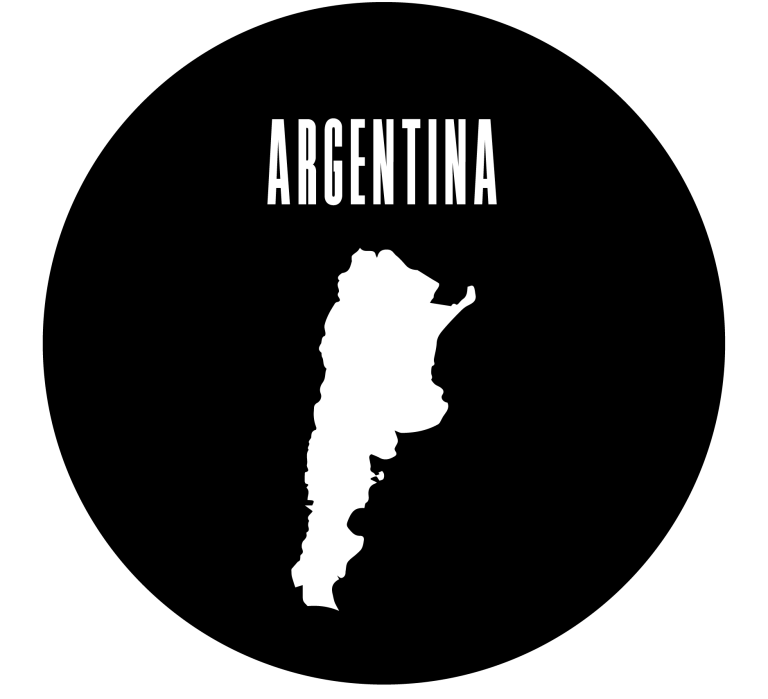
Finances in Argentina
A few years ago, Argentines started hoarding US dollars because it was a much more stable currency than the Argentine peso. Therefore, the Dollar Blue was introduced in 2002 to help Argentines avoid the exchange controls introduced by the government. The Dollar Blue is the informal name for the US dollar banknotes circulating at a much higher exchange rate than the official Argentine peso. Even before our trip, some friends advised us to use this Blue Dollar, which is also recommended in many blog posts and forums. The most common way is to open a Western Union account and send money to yourself, which you pick up at a Western Union (WU) location in the form of Argentine pesos. As a comparison: You would have received 242 ARS for 1 CHF at a bank ATM. This way, it was 446 ARS. As good as all this might seem, it turned out to be a lot more complex. While initially, we were lucky, and a WU location was opposite our café. They also had enough money that day, and we were able to pick up our first transfer. This was not always the case on the following days, and we had to pilgrimage from WU location to WU location to check whether they still had enough cash. That became too tiring for us, and we researched for more information. As already written, we found out that on 4 November 2022, the Argentine Central Bank introduced a preferential exchange rate for foreign tourists. The so-called “foreign tourist dollar” means that for payments with foreign credit cards, the “MEP” (Electronic Payment Market) US dollar exchange rate applies, which is currently AR$ 331.79 per dollar. So far, this “foreign tourist dollar” applies only to purchases, not ATM withdrawals. Who knows, maybe that will also change soon.
Gallery
Wir benötigen Ihre Zustimmung zum Laden der Übersetzungen
Wir nutzen einen Drittanbieter-Service, um den Inhalt der Website zu übersetzen, der möglicherweise Daten über Ihre Aktivitäten sammelt. Bitte überprüfen Sie die Details in der Datenschutzerklärung und akzeptieren Sie den Dienst, um die Übersetzungen zu sehen.


